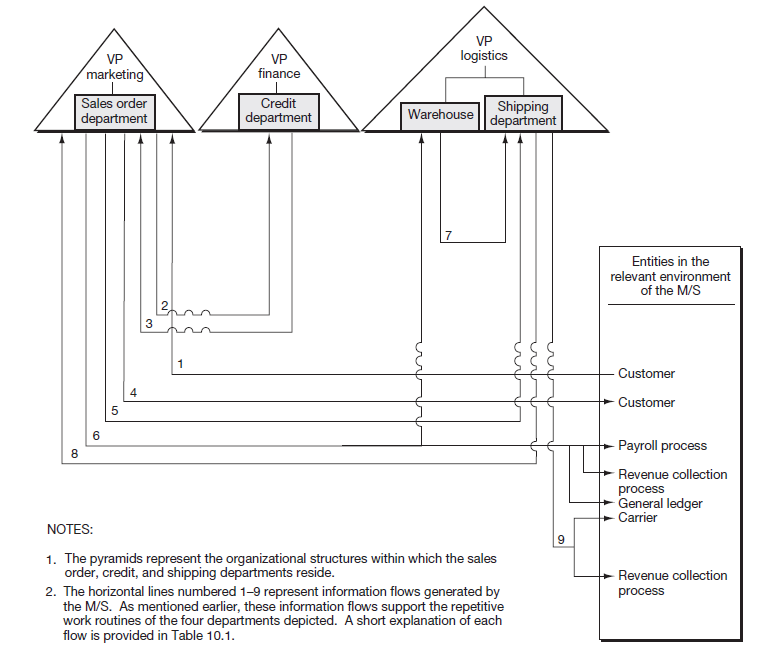|
|
Figure 11.2 and Table 11.1 present a horizontal view of the relationship between the M/S process and its organizational environment. The figure shows the various information flows generated or captured through the M/S process. The information flows are superimposed onto the organizational structures that house the departments. The figure also illustrates the multiple entities with which the M/S process interacts (customers, carriers, other business processes, and so forth). |

|
Flow No. |
Description |
|
1 |
Customer places order. |
|
2 |
Sales order department requires credit approval from credit department. |
|
3 |
Credit department informs sales order department of disposition of credit request. |
|
4 |
Sales order department acknowledges customer order. |
|
5 |
Sales order department notifies shipping department of sales order. |
|
6 |
Sales order department notifies warehouse, revenue collection process, payroll process, and general ledger process of sales order. |
|
7 |
Warehouse sends completed picking ticket to shipping. |
|
8 |
Shipping department informs sales order department of shipment. |
|
9 |
Shipping department informs carrier and revenue collection process of shipment. |
|
*Many of these steps may be automated. See Technology Insight 10.1 for a description of these steps in an enterprise system implementation. |
|
Figure 11.2 reveals nine information flows that function as vital communications links among the various operations departments. The information flows also connect those departments with the entities residing in the relevant environment of the M/S process. If the order itself were initiated over the Internet or other EDI-based system, many of the flows would be automated and require less human intervention.
For example, the first information flow apprises representatives in the sales order department of a customer request for goods. This information flow, the customer order, might take the physical form of a telephone call, a mailed document, or an electronic transmission. In turn, flow 5 informs workers in the shipping department of a pending sale; this communication facilitates the operational planning and related activities associated with the shipping function. This information flow, the sales order, might take the form of a copy of a paper copy of a sales order, or it might be electronically transmitted and observed on a computer screen in the shipping department.
|
Review Question Which entities, shown as external to the M/S process, also are outside the “boundary” of the organization and which are not? |
|
|
As noted earlier in the text, many of the information flows through an organization become automated when enterprise systems are in place. Having reviewed the information flows in Table 11.1 and Figure 11.2, you should take a few minutes now to read Technology Insight 10.1, which discusses how the horizontal information flows in an enterprise system become automated and, therefore, more efficient in terms of supporting the M/S process. |
- 5011 reads








